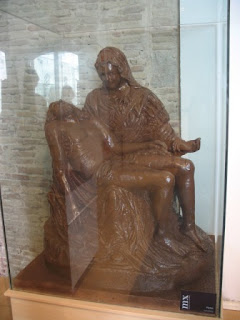Our trip began last Wednesday in Barcelona. We stayed four nights in a little apartment at the northern end of the Eixample and walked miles and miles through Eixample, Old Town, and Montjuïc.
Although one can happily cover great distances by foot in Barcelona, cars clearly have first dibs on the roads. Drivers are remarkably good about going from 60 to 0 kph when pedestrians have the right of way, in exchange for which the pedestrians wisely stay within the crosswalks. Crosswalks are located an eighth of the way around the corner of every block to give cars room to decelerate, to make room for parking, and to give walkers 25% more exercise. At the busiest intersections, stenciled paint in the crosswalks reminds walkers that one out of every three traffic related deaths in Barcelona is a pedestrian, so atencio!, pay attention.
Like most large international cities, Barcelona boasts impressive architecture. Its most beloved architect was Antoni Gaudi, whose Catalan modernism featured undulating waves and spirals and biologically-inspired appendages. Had hobbits ever abandoned the shire for urban condominiums, Gaudi would have been their guy.
The Casa Batlló (1906): condos for the hobbit elite on fashionable Passeig de Gracia:

After designing houses and parks for the wealthy, Gaudi turned his attention to a massive church--La Sagrada Familia--a giant sand-drizzly religious effusion.
 Nearly a century after Gaudi's death, Barcelona remains committed to completing the church, which means hiring other designers to work on it. Like Gaudi's east entrance, the west entrance also has four huge towers, though less drizzly, with a facade in a completely different style and designed by a completely different architect (Josep Maria Subirachs).
Nearly a century after Gaudi's death, Barcelona remains committed to completing the church, which means hiring other designers to work on it. Like Gaudi's east entrance, the west entrance also has four huge towers, though less drizzly, with a facade in a completely different style and designed by a completely different architect (Josep Maria Subirachs).
In elegant and austere contrast to the Sagrada Familia (1883+) and Barcelona's Catedral de la Santa Creu i Santa Eulàlia (built primarily in the 13th-15th centuries), the gothic Basilica Santa Maria del Mar was constructed in a mere 54 years, between 1329 and 1383, which makes it the only church built entirely in the Catalan gothic style:

No such unity for La Sagrada Familia, which, for better or worse, could swallow the Basilica whole. Gaudi's megalith towers over the rest of Barcelona despite still missing its gargantuan central dome. The only other building in Barcelona that comes anywhere near La Sagrada Familia's height is a giant sparkly phallus (below, to the left), owned by the water works:

The lines to get into La Sagrada Familia were longer than our patience, so we decided to visit the Museu de la Xocolata instead. There we saw La Sagrada Familia, the organ from Montserrat abbey, Asterix and Obelix, and Michaelangelo's Pietà lovingly rendered in chocolate.

Other Barcelona highlights included a brief trip to the beach and a leisurely amble through the Joan Miró museum (Fundació Joan Miró) on Montjuïc. Mixed in were the more mundane aspects of being a tourist: learning some of the differences between Catalan and Spanish, avoiding copious puddles of dog pee on the sidewalks, recovering lost luggage, and disentangling the complexities of internet and cell phone access (the difficulty of which, according to one Vodafone employee, supposedly has to do with government vigilance against terrorism).
*Not in Southern Germany, but closer to Southern Germany than to North Carolina.

No comments:
Post a Comment